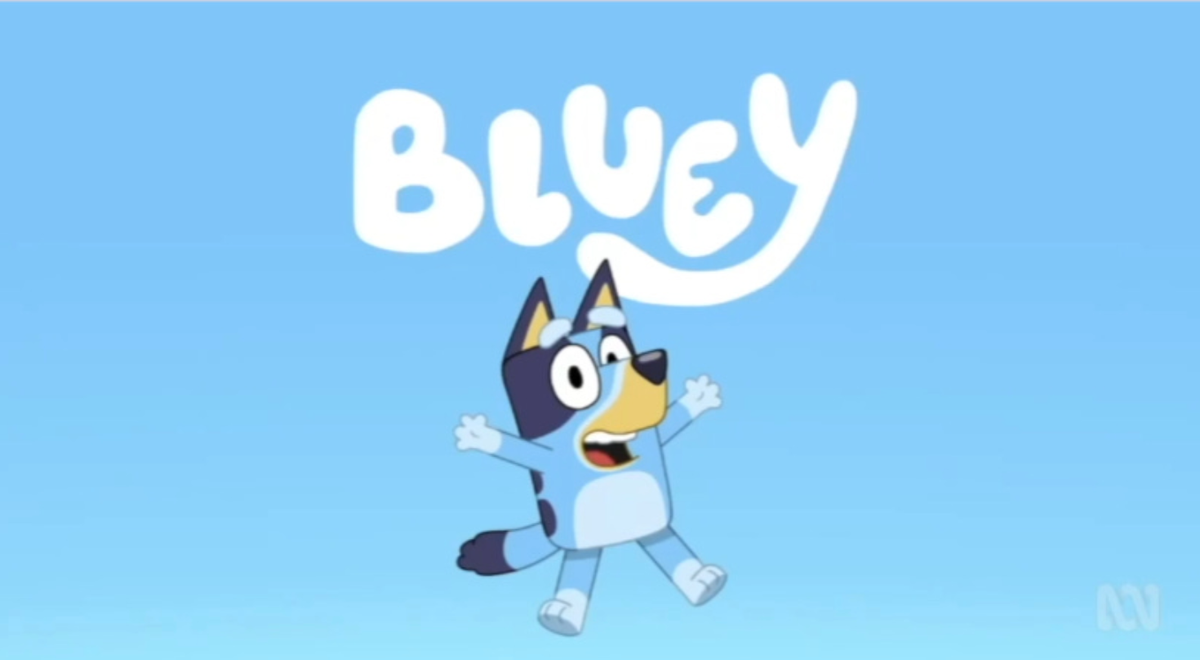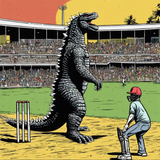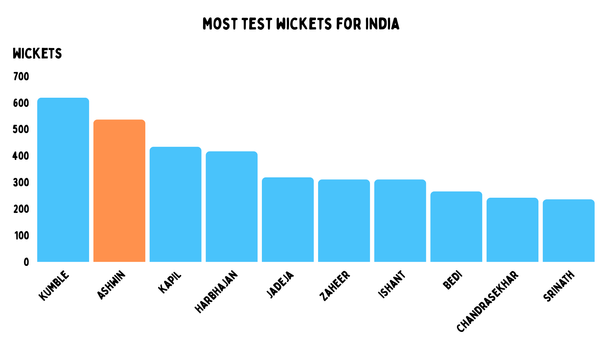When Bluey changed cricket: A Review
When the blue dog, her red sister and dad play in a cricket match, it could have a long term effect on the game worldwide

Shout out to our new sponsor Nord VPN. Click on their link and get your EXCLUSIVE Deal. Get a Huge Discount off your NordVPN Plan + 4 additional months for free! If you don’t like it, cancel it within 30 days.
This is one of the most important pieces of media ever made on cricket. It is also aimed at 4-year-olds. If you don’t have kids around that age, you may have no idea what this is, or why it matters.
But when the blue dog, his red sister and his dad play in a cricket match, it could have a long-term effect on the game worldwide.

Rusty, a background character in the show, tells his sister he can’t hit her a catch because he’s nearing 50. What could be more cricket than this?

So what is all this? Bluey is a kid’s cartoon that has been around for a few years and came out of Queensland - perhaps their best export since Matt Hayden. Being an Australian show, cricket is often mentioned in the background.

Sometimes that can be confusing to non-cricket nations. Like that one time when a mum got confused with a cricket bat and assumed it was actually a wine bottle.

But this episode is all about cricket. And the show has done a lot about hockey, Rugby League and squash before. But they have always been background parts. This is an episode about cricket, it is the main reason it exists.

This episode actually came out during the World Test Championship final, and is arguably better than anything the ICC - or any board - have done to grow the game.
I didn’t watch it at the time because I know much of my life is already taken up by Bluey. I wasn’t searching out an episode, being that I’ve already seen available one 15 times each. But the new episodes just dropped on Disney+ and other platforms, so I watched the cricket episode for the first time. And like I did for Aaron Sorkin, I wanted to go through the cricket.
In the episode, after Bluey bowls out his sister, who also knocks her own stumps down, they decide they’ve had enough and want to play chase. Bandit - the dad - says after they get Rusty out. The only problem is, no one gets Rusty out and he slams the first ball back down the ground for a boundary.
Bandit, like any cricket dad, decides to bowl properly to the kid who just smashed him, so he says, "You right with a bit of swing, Rusty?" This is really early on, and it instantly sets up that this is really about cricket. Like deep in its bones.

Because it is Australia, we see some sledging as well. Bandit tells everyone to move in when his brother has a hit.

Also worth having a look at this ground, it’s a park ground, but an astro turf wicket. Again, this is a detail most kids’ shows wouldn’t worry about.

But it gets so much more crickety from here. If you watched cricket in the 90s in Australia, you had to get used to Tony Greig using a telestraighter to draw lines on the screen to tell you things.

So when one of the other dads comes up with a plan to dismiss Rusty, and they cut to a fielding map where they move in the gully and point close together. I would argue that this is too square for a gully fielder, it is actually more like the two-point fields that Stephen Fleming used for Damien Martyn. They also talk about bowling to his off stump, but if you really want him to cut, it should be wider than that.

It doesn’t matter anyway, Rusty picks the gap like prime Graeme Pollock or Meg Lanning.
But how he does it is really interesting. Many Australian batters are thought to have their games shaped by how they played cricket at home. And here, as Rusty almost kills his mum with a cut, he has to practice finding the gap to stop her getting angry.

This is such a well-known thing in Australia that Steve Canane wrote an entire book on how so many Australian cricketers were shaped by their homes.
Also worth pointing out this isn’t just an Aussie thing. Many cricketers from around the world are shaped by where they first learned cricket. Viv Richards apparently hit to the legside because shots to the off at his school went over a neighbour’s fence.

But the way the location shapes Rusty as a cricketer is really interesting. After almost killing his mum, he throws the ball against the wall and practices hitting accurately. This is probably a homage to Don Bradman. Note the water tank and stump here.

This is what Don Bradman did at home when he was a kid: throw a golf ball at a water tank and hit it with a stump. It’s not exactly the same, but certainly close enough to suggest a relationship, especially as there is no way the people who made this didn’t know of how Bradman did his training as a kid.

The creator has already talked about how they also tried to replicate Bradman’s first pitch. Not to mention that he used things from Rugby League and Wayne Gretzky in the making of the episode. Gretzky had a great cover drive.

So after Rusty’s house ruins their fielding play, Stripe comes on to bowl and the idea is to get the young fella with spin. Bandit tells him to aim at a rip in the astroturf, but it’s worth pointing out where this is - outside leg stump, and a good place for a leggie to bowl.

Like say, the kind that Shane Warne would do.

But then we see again that young Rusty is used to his kind of ball from his mate’s yard. So he is used to it. Reminds a little bit of Sachin Tendulkar having the pitch dug up so he could prepare for Warne bowling into this spot. I am disappointed Stripe didn’t come around the wicket.

Somehow Stripe does hit the tear (first time, with cricket’s least accurate bowling, what a legend). Yet Rusty still smashes the ball away. Seriously, this kid looks unstoppable.

And that is on purpose because they used Steve Smith as a model for how Rusty bats. But they also nicely ignored him walking across the crease and playing across the line, to ensure that other kids play straighter.
But a bit like Smith and Jofra Archer, Rusty’s issue is pace.

The parents have had enough, and now they want to bowl fast at him.
Now we see a different backstory, one where Rusty is playing games with his older brother. This is on a dodgy black rubber wicket, against a proper cricket ball.

This is my favourite bit, watching a kid play against a real cricket ball at pace for the first time. I still remember facing my first delivery of a quick bowler with a real ball. It’s intense, and Rusty goes through it too. So much so that he sends a letter to his dad in the army, asking for advice.
His dad writes back,
“But look, as you grow up, you'll face harder things than a cricket ball, and you'll have two choices. Back away and get out... or… step in front... and play a pull shot.”

This is more or less what my dad told me when I was a kid, minus the harder things in life part. Not sure why Rusty’s dad thinks you need to step out in front to play a pull shot unless he’s talking of the rarely played front-foot pull. But let’s not dwell on that, because the message is nice.
But there are a couple of other things here, Rusty’s dad also asks him to look after his sister while keeping his eye on the ball. At the start, we mentioned that he doesn’t give her a catch, but at the end, having smashed the dads everywhere, he finds his sister for a catch, despite her being the only fielder out there.

You can see the dad’s shock at the skill of the shot, and the nice gesture.

And then Rusty walks off the field. But the final touch is that as he walks off he meets future Rusty, the Test cricketer out on the Gabba. This tells us that the story Bandit is telling us is in the future, when Rusty makes it.

Also, worth noting they nailed the running on the spot movement that cricketers do on their way out to bat.

This whole thing is also a throwback to the Cricket Australia using the backyard to baggy green as an advertising campaign a while back. But of course, that comes from the many times in Australian cricket his idea has been mentioned. There is no doubt that from the sledging to the backyard element, this is about Australian cricket.

But why does a kids’ show matter this much? Well, Bluey isn’t just some random show. And there is a cricket connection to why Bluey is important.
When Kerry Packer started World Series cricket, he was at war with the Australian Cricket Board over wanting the rights. The reason Packer wanted sport was because Australia had a minimum amount of content that you had to show on TV that was Australian-made.
The two best things in terms of hours and cost were sport and kids TV. That is why you probably have heard of Bluey, the Wiggles or Bananas in Pyjamas. Australia produces a lot of quality kids’ content.
But the important thing here is that the Bluey episode is not going to be watched just now, as a one-off, like most TV shows for adults, are. It will be watched millions of times for the next decade. If Bluey continues to grow as it is, then that will be even more. Especially if it reaches new markets. So cricket will have perhaps one the greatest bits of promotion ever made about it, being force-fed to kids aged 4-8 for a decade.

But also, because it is so well made, and is about cricket, rather than it being just a plot device, it can be more powerful than normal.
Lagaan, the Bodyline series and other movies about cricket have never taken off outside core cricket markets.

I spent years trying to sell a cricket sitcom - in England - and was told there is no way you can make it on cricket. In seven minutes with a bunch of angry dad dogs trying to dismiss a kid, this children’s show probably created the best fiction on cricket.
How we present our game is as important as what happens on the field.
And when coupled with the popularity of this blue dog and her red sister, it means cricket has a real chance to be seen outside of cricket markets. And maybe some kids will start to wonder if cricket is more than just hitting a ball around some grass.



